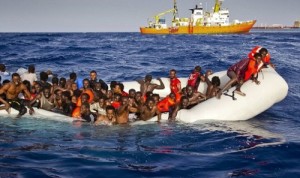Illegal migrants from Nigeria, account for 21 per cent of the total 171, 299 immigrants that braved the Mediterranean odds to arrive Italy in 2016.
Figures from the Italian Interior Ministry estimated the record of Nigerian arrivals at 36,000, with most of them claiming they were running away from Boko Haram insurgency or Niger Delta crisis.
The estimate was as at November 2016.
The Nigerian government was briefed by Italian authorities on this development late last year.
Sources said the Nigerian government regarded the high number of Nigerians seeking asylum abroad as ‘’mind boggling and embarrassing”.
Government is of the view that only a few of the migrants could genuinely claim they were fleeing from Boko Haram insurgency and Niger Delta crisis.
“Most Nigerian migrants pictured in this milieu, are motivated by economic and pecuniary interests”, said a spokesman for Babachir David Lawal, the Secretary to the Government of the Federation.
From all indications, government may soon begin a campaign to dissuade the young Nigerian ‘‘opportunity seekers” from embarking on the “perilous Mediterranean crossings in their bid to emigrate to Europe”.
“The dangers and rigours of the expeditions entail extreme negative prospects compared to the vibrant opportunities that Nigeria as a nation is still blessed with”, said the statement, signed by U. Onwuanukwo, on behalf of Lawal.
According to Frontex, the European Union border agency, some 181,000 migrants eventually arrived in Italy last year from North Africa, the highest number ever recorded. It was 20 per cent more than last year.
The largest group of migrants arriving were Nigerians, Eritreans and Guineans, the agency added.
Nigerians, along with Guineans also formed the bulk of migrants rescued at sea, especially in November, said Frontex in a report published on Dec.9.
The flow of Nigerian immigrants to Italy via the Mediterranean backdoor began in 2008 and declined for five years. From 2013, the number jumped.
In sorting out the migrants, Italian and European authorities have been able to distinguish between migrants from war torn states such as Syria from the hordes of economic refugees from Africa.
“The flow from Syria and Iraq is somewhat contingent while that from Africa is structural.
Some European citizens support welcoming refugees from Syria while support for African economic migrants among public opinion is extremely low,” Mattia Toaldo, senior policy fellow at the European Council on Foreign Relations said.
Italy meanwhile, has reopened its embassy in Libya to enable its officials work with Libyan government to stem the flow of immigrants, through the Libyan route, the most popularly used by Nigerian migrants.
The Italian Interior Minister Marco Minniti announced the decision on Monday.
The embassy was closed down in 2015, along with all other Western embassies as the North African country descended into violence.

